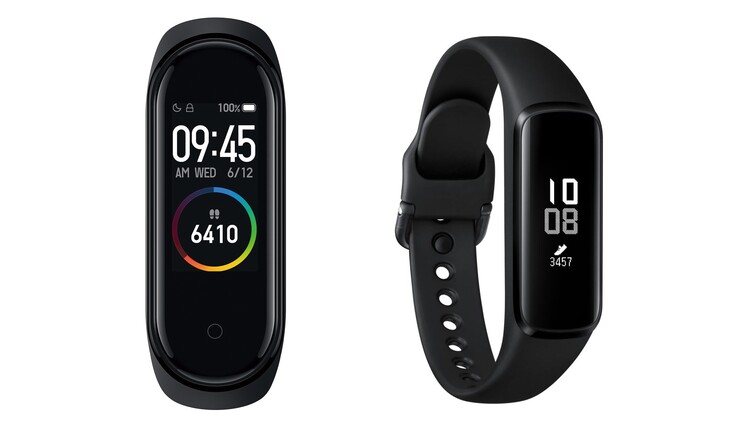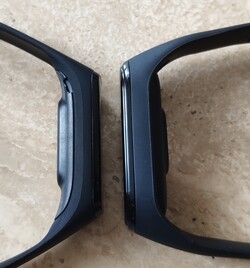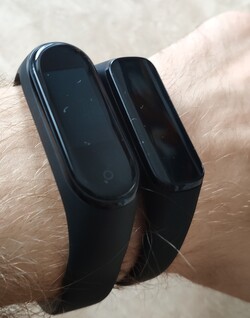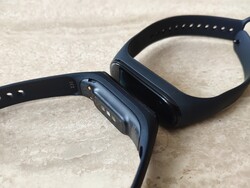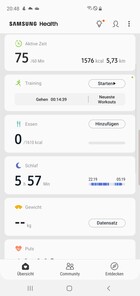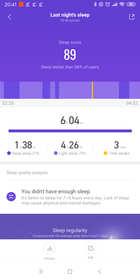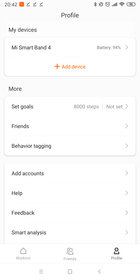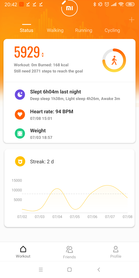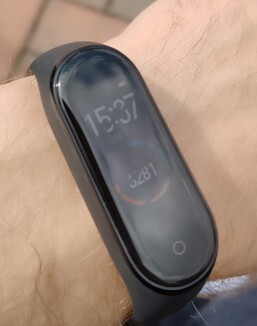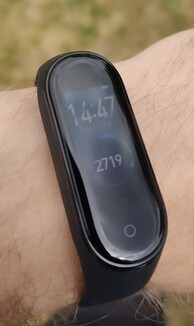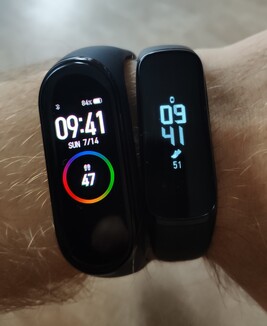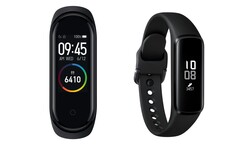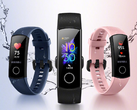Only one fitness tracker is worth its salt: Xiaomi Mi Band 4 and Samsung Galaxy Fit e in review
It was Xiaomi that revolutionized the fitness tracker with its Mi Band just a couple of years ago. Long battery life and plenty of features paired with an affordable price resulted in an amazing price performance ratio for Xiaomi’s fitness bands. The company’s overwhelming success was thus not particularly surprising. Sales figures for the latest incarnation, the Mi Band 4, claim roughly one million units sold within the first 8 days. Samsung’s Galaxy Fit e is a newcomer in this market, and is pitched by the Korean manufacturer as an alternative to Xiaomi’s Mi Band trackers.
The Galaxy Fit e is available in Black, Yellow, and White and offered at an MRSP of 40 Euros (~$45). It is not yet officially available on the other side of the Atlantic so we cannot yet say how much it is going to sell for. Suffice it to say that its more expensive sibling, the Galaxy Fit, sells for 99 Euros (~$111) in Europe and $89 in the US. The Mi Band 4 can be imported for 169 Yuan directly from China, which equates to just over $30, or purchased for $40 in the US.
Both bands include a sleep tracker as well as a step counter and heart rate monitor. Both include an OLED display to show current usage data such as steps or heart rate, and both support notifications from Android and iOS devices. Additional information is available in the respective smartphone app for each band.
| Xiaomi Mi Band 4 | Samsung Galaxy Fit e | |
|---|---|---|
| Size | 47 x 17 mm | 40,2 x 16,0 mm |
| Weight | 22 g | 15 g |
| Display | AMOLED, color, 0.95-inches, 120 x 240 Pixel | PMOLED, monochrom,e 0,74-inches, 128 x 64 Pixel |
| Battery | 135 mAh | 70 mAh |
| Sensors | accelerometer, gyroscope, heart rate sensor | accelerometer, heart rate sensor |
| Connectivity | Bluetooth 5.0, NFC | Bluetooth 5.0 |
| Protection | 5 ATM | 5 ATM, MIL-STD-810G |
Case
Both contenders are comprised of two separate components: the display unit itself and a rubber wristband. Given that the Mi Band 4 has remained identical to its predecessor the accessories remain compatible. The wristbands are both very elastic and comfortable, and the differences between them are mostly negligible save for length and locking mechanism. Overall, we found the Mi Band 4’s mechanism to be much simpler to use than the Galaxy Fit e’s, particularly when attempting to close it one-handed. In addition, the Fit e’s wristband was comparatively short, and only 1 of 11 holes remained free when worn on an average-sized male wrist.
The tracker unit itself is made of plastic in both cases, and both are protected against dust and water ingress up to 5 ATM. In other words: both can be worn in the shower and the pool. Unlike the Band 4, the Galaxy Fit e is MIL-STD-810G tested for mechanical shock and variations in temperature (-40 °F to 145 °F). At 15 and 22 g (~0.5 and ~0.8 oz) both devices are virtually unnoticeable after a while.
The heart rate sensors as well as charging contacts are located at the bottom of each device and they are charged using USB cable.
Connectivity
In addition to displaying incoming notifications from your smartphone on their OLED screens, both units include a vibration alarm. Both fitness trackers support Bluetooth 5.0, the Mi Band 4’s predecessor was limited to Bluetooth 4.2 LE. Notifications sent from your connected smartphone to your band include incoming calls, messages, and app notifications, and both support an alarm clock vibration feature that can be setup in their respective app.
Unlike the Samsung Galaxy Fit e the Mi Band 4 is optionally available with NFC and embedded microphone, and can be used for launching the Xiaomi assistant or contactless mobile payment systems. However, the Alipay service used for mobile payments is not particularly common outside of Asia and only supported by a select few retailers in Europe and North America.
The Mi Band 4 is further equipped with an accelerometer, a heart rate sensor, and a gyroscope. The Galaxy Fit e lacks the latter.
Features & Handling
The Mi Band 4 is operated via swipe gestures performed on the OLED display. For example, swiping from top to bottom opens a menu, and swiping from left or right launches the integrated music player. The touch-sensitive sensor right underneath the display is used among other things for navigating back. In comparison, Samsung’s Galaxy Fit e is not as sophisticated and only capable of a simple tap gesture to alternate between the screens configurable in the smartphone app, which include a step counter, sleep analysis data, or burned calories.
Waking up both bands from sleep is done by either raising your arm or tapping the display or, in the Mi Band 4’s case, the sensor underneath the display.
Both bands include algorithms to automatically detect activities such as running, fast walking, or even swimming and categorize them accordingly. Both heart rate monitors are capable of recording, however, unlike the Mi Band 4 the Galaxy Fit e can only start and stop recording from within the smartphone app. The Xiaomi Mi Band 4 allows recording of individual heart rate reading points from the unit itself, however continuous plotting will require the Mi Fit app. Keep in mind that changing the Mi Band 4’s language to anything other than English will require the Custom Mi app.
Counted steps and recorded heart rate were more or less comparable during our test period with the Galaxy Fit e’s step counter exceeding the Mi Band 4’s by around 10-20% on average, but we found the Fit e’s data to be less accurate. While we did not compare our heart rate measurements to those of a professional heart rate monitor, they seemed plausible overall. Sleep tracking also worked reliably well during our test period, and both devices accurately recorded sleep times and wake after sleep onset periods. All things considered the recorded sleep data seemed accurate and plausible.
Software
The Galaxy Fit e supports smartphones running Android 5.0 or higher or iOS 9.0 or higher. The Xiaomi Mi Band 4 requires Android 4.4 or higher or iOS 9.0 or higher. Connecting the fitness tracker to your smartphone is achieved via an app available for free in both app stores. Samsung’s app is called Samsung Galaxy Wearable App (Android) or Samsung Galaxy Watch App (iOS), Xiaomi’s app is called Mi Fit on both Android and iOS.
In combination with Samsung’s own Wearable/Health app the Galaxy Fit e tracker is capable of detecting and recording various activities that can then be analyzed and evaluated using the app. It also supports various widgets and notifications.
Display
One of the Band 4’s major new features is its 0.95-inch color screen with a resolution of 120x240 pixels. Unlike the Galaxy Fit e’s monochrome display the Band 4’s AMOLED display supports 16,000 colors. In addition, it is much larger than the Fit e’s 0,74-inch 128x64 PMOLED display. Individual pixels are visible on the latter, but were not particularly bothersome on the monochrome display.
Unlike the Mi Band 4, the Fit e’s display does not support multiple brightness levels, and its comparatively low brightness results in a display that remains at least somewhat readable outdoors in the shade. It is, however, hopelessly out of its depth in bright sunlight and its reflective coating does not help at all.
In comparison, the Mi Band 4’s maximum brightness was high enough to render the tracker usable and readable even in bright sunlight with some shade provided, for example by covering the tracker with your hand.
As is quite common for OLED displays both trackers to use PWM for brightness regulation, which turns the display on and off periodically at a high frequency in order to regulate brightness.
Due to its excessive PWM, we were unable to take a photo of the Galaxy Fit e head-on in bright environments.
Battery Life
The Mi Band 4’s lithium-polymer battery is rated at 135 mAh, the Galaxy Fit e’s at just 70 mAh. According to Samsung, the battery should last for around 7 days of normal use and up to 13 days of light use. However, we were unable to get even close to those numbers in our tests. Without using the heart rate monitor and with only a few incoming notifications we lost around 15% charge per day simply by keeping the Galaxy Fit e connected to our smartphone via Bluetooth. Activating the heart rate monitor recording feature will drain the battery by around 1% per hour.
The Mi Band 4, on the other hand, performed much better. According to Xiaomi, the battery is supposed to last for up to 20 days. When used only occasionally we lost around 3 % charge per day. Using all features, including sleep monitoring, a large number of incoming notifications, and heart rate monitoring during a 30-minute workout with the display set to maximum brightness resulted in a much higher battery drain of around 10% per day. In other words: average use presupposed three weeks of battery life are feasible.
Both bands take between 1.5 and 2 hours to charge from near empty to full.
Verdict
Once again Xiaomi’s latest Mi Band is the price-performance ratio reference when it comes to fitness trackers. At around $40 you get a fitness band that leaves little to be desired.
The Samsung Galaxy Fit e is not fit to hold a candle to Xiaomi’s Mi Band 4.
Build quality is decent, battery life is exceptional, and the display is bright enough in bright sunlight and can be dimmed for indoor use at night. If there is one thing we would like to add it would be a GPS tracker for geotagging and tracking activities. In addition, given the OLED display and the exceptionally long battery life we would love to see some sort of optional always-on feature.
The Galaxy Fit e, on the other hand, does exactly what a fitness tracker is supposed to do: it records and tracks activities. Compared to the Mi Band 4 Samsung’s tracker offers less for roughly the same amount of money. All the Band 4’s virtues listed above, save for the build quality, are non-existent on the Fit e. In addition, we were not impressed by its wristband’s locking mechanism and the heart rate recording feature that only works from within the app. And last but not least, we also found that the Fit e’s number of recorded steps was too high.




